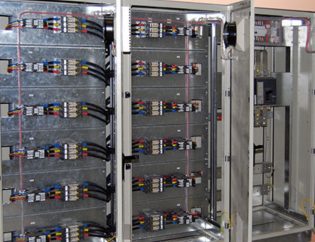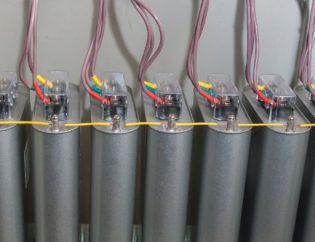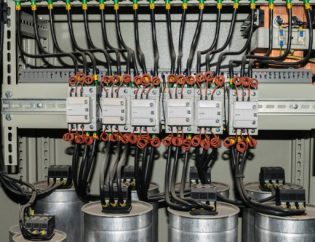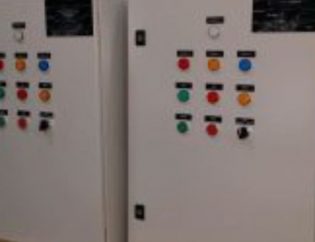In the early days of electricity, capacitor banks were essential only for public powerhouses with low-level technology in an isolated setting.
But nowadays, capacitors have all kinds of technological applications, ranging from small-sized MEMS devices to large-scale wind farms.
No matter where you use capacitor banks, it has a simple application: storing electrical energy and regulating the flow of energy.
This post makes you aware of capacitor banks, their types, testing, applications, and reasons for capacitor bank failure.
What is a Capacitor Bank?
By definition, a capacitor bank is a device where several capacitors of the same capacitance are joined together. These capacitors can be connected in a series connection or a parallel connection.
The role of a single capacitor is to store electrical energy, and the capacitor bank’s purpose is to store electrical energy in a greater volume.
By increasing the number of capacitors in a capacitor bank, you can increase the capacity of a capacitor bank to store electrical energy.
A capacitor bank can be used both for AC power supply and DC power supply. With AC power Applications, capacitor banks are used to correct the power lag factor or to counter the phase shift. On the other hand, with DC power applications, capacitor banks are used to increase the total amount of stored energy or uplift the ripple current capacity.
Capacitor Bank Diagram

Capacitor Bank: Theoretical Knowledge
To understand the importance of capacitor banks, you must be aware of electrical power systems. Here is a brief overview.
Types of loads in electrical power distribution systems
Power loads can be categorized into three types in all electrical energy distribution systems.
- Resistive load
- Inductive load
- Capacitive load
Incandescent bulbs and heaters use resistive loads.
Motors, refrigerators, and air conditioners use inductive load.
Capacitors use capacitive load.
There are three types of power in electrical power distribution systems.
- Active power
- Reactive power
- Apparent power
Active power does the work and is calculated in watts.
Reactive power creates the magnetic field that is required by the types of equipment to function properly. It is calculated in VAR.
The apparent power is created by the combination of active power and reactive power addition. It is calculated in Volt Amperes.
You get the power factor by dividing actual power by apparent power.
A lot of equipment requires consistent reactive power to function properly. And a capacitor bank provides consistent reactive power when it is installed in parallel to the load.
Also, a capacitor bank helps to correct the power factor by reducing the phase difference between current and voltage.
In short, a capacitor bank acts as an instrument in all electrical substations to correct the power factor and compensate for reactive power.
How to Calculate Capacitance?
Capacitor manufacturers give every capacitor a rating, which is its capacity to store electrical energy and ability to correct power faults. It is measured in Farad.
The capacitance of a capacitor bank is measured by adding the rating of all capacitors present in the capacitor bank.
Capacitor Bank Connections
There are two ways to connect a capacitor bank in an electrical distribution system: star connection and delta connection. The purpose of these connections is to correct the power factor in a 3-phase electrical system. Both connection types have their benefits and drawbacks.
Capacitor Bank in Delta Connection

The delta-connected capacitor bank is best for low to medium-voltage applications. It uses the full phase of voltage. That’s why the delta connection is not feasible for high-voltage applications.
Delta-connected capacitor bank circulates the harmonic current and reduces the harmonic effect in an electrical system. Also, it delivers a balanced voltage and capacitance.
There is only one drawback of delta-connected capacitor banks. Its life is too short. That’s why you have to replace them often.
Capacitor Bank in Star Connection
Star-connected capacitor banks are best for medium to high-voltage applications. The voltage is rooted three times lesser than the phase voltage across each capacitor in a star-connected capacitor bank.
There are two types of star connections
- Grounded star connection
- Ungrounded star connection
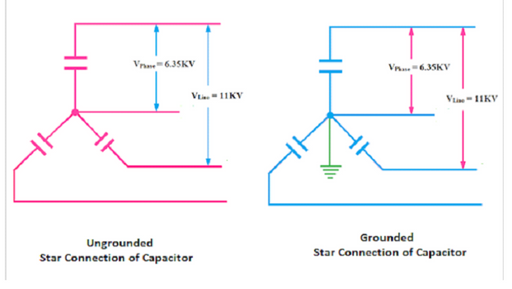
Grounded star connection uses a neutral point that is connected to the earth. On the other hand, an ungrounded star connection uses a neutral point that is not a connection to the earth.
Star-connected capacitor bank has a simple working, and its life is long.
However, star-connected capacitor bank has disadvantages.
It provides less voltage than a delta-connected capacitor bank and does not provide harmonic current. Moreover, it does not supply a balanced voltage and capacitance.
Capacitor Bank Applications
Electrical appliances and equipment need a lot of electrical energy to operate productively. Also, the flow of energy needs to be smooth. For that, capacitor banks are ideal instruments because they are made to store electrical energy charges and streamline the flow of electrical energy.
Typically, capacitor banks are used for the following purposes.
- Capacitor banks are used for shunting in electrical systems. Shunting is when the electrical current is passed through the least resistance path to save the electrical system. In other words, shunt capacitor banks improve the efficiency of electrical distribution systems.
- Capacitor banks are used for power-factor correction. Such an application is very useful for motors, transformers, and large electrical machines.
- Capacitor banks are used to store energy. Such an application is very useful for equipment that requires reactive power on demand to maintain the operations of the machine.
- Capacitor banks are also used in large-scale electrical energy equipment, such as wind farms.
- Capacitor banks are widely used in manufacturing, where machines require balanced voltage and current.
- Capacitor banks are also used in micro-electro-mechanical systems (MEMS) that use radio frequency and wireless space for the convenience of mankind. Smartphones are the best examples of it.
- Capacitor banks are also used in weapons, such as laser guns.
- Capacitor banks are also used to create high-intensity electromagnetic fields required for scientific research.
- Scientists are working on using capacitor banks to create electromagnetic armour and weapons. Initial research has created rail guns and coil guns.
Advantages and Disadvantages of a Capacitor Bank
Advantages
- You can store energy quickly for the latter and immediate usage.
- Capacitor banks supply energy quickly without any delay.
- Capacitor banks have low losses of electrical energy.
- You can enjoy the service of a capacitor bank for a long time.
- Capacitor banks are simple to operate and install.
- You can use capacitor banks with both AC and DC power supplies.
- Capacitor banks are inexpensive devices. If they malfunction, you can replace them cheaply.
- Capacitor banks can be used all over the industrial, residential, and commercial electrical distribution systems.
Disadvantages
- Capacitor banks cannot compete with batteries.
- You can store a limited amount of electrical energy.
- If you leave the capacitor bank, its energy will deplete with time.
- Capacitor banks provide variable levels of voltage.
How Can a Capacitor Bank Fail?
Nowadays, capacitor manufacturers use self-healing technology in capacitors. In case of any dielectric fault, the capacitor heals itself by emitting gases. Yet, a capacitor bank can fail due to many reasons. Here are two frequent ones.
Harmonics and Detuned Capacitors
A capacitor bank can fail due to overloading, which can be caused by harmonics. You can understand harmonics as a current or voltage with a too-large frequency. When a capacitor bank is exposed to harmonics, its elements get fused. As a result, the capacitor bank malfunctions or fails to perform.
Resonance
Resonance happens when the most dominant frequency enters the electrical system and the capacitor bank, along with the transformer, provides the low-impedance path. As a result, the capacitor bank malfunctions or fails to perform.
What is Capacitor Bank Testing, and Why is It done?
The most common role of a capacitor bank is to correct the power factor in an electrical distribution system. But several factors lower the ability of the capacitor bank to correct the power, such as temperature, moisture, harmonics, and time.
Capacitor bank testing is necessary before installing it because it ensures the proper functioning of an electrical distribution system.
Types of Capacitor Bank Tests
Capacitor bank testing falls into three types of different tests.
- Design Tests or Type Tests
- Production Test or Routine Tests
- Field Tests or Pre-commissioning Tests
Conclusion
A capacitor bank helps to maintain the quality of operations of any electrical distribution system. Also, they are the best instruments to store electrical energy for frequent usage. Moreover, capacitor banks are inexpensive devices that provide splendid value with their long life and usability.
Without capacitor banks, the world we are living in is not possible.
However, before installing a capacitor bank, it should be tested. So, there can never be a performance issue in the electrical distribution system.


